
Bridge of Constellation class NCC 6236 U.S.S.Montrose. Images of the Enterprise-A used for illustration purposes.
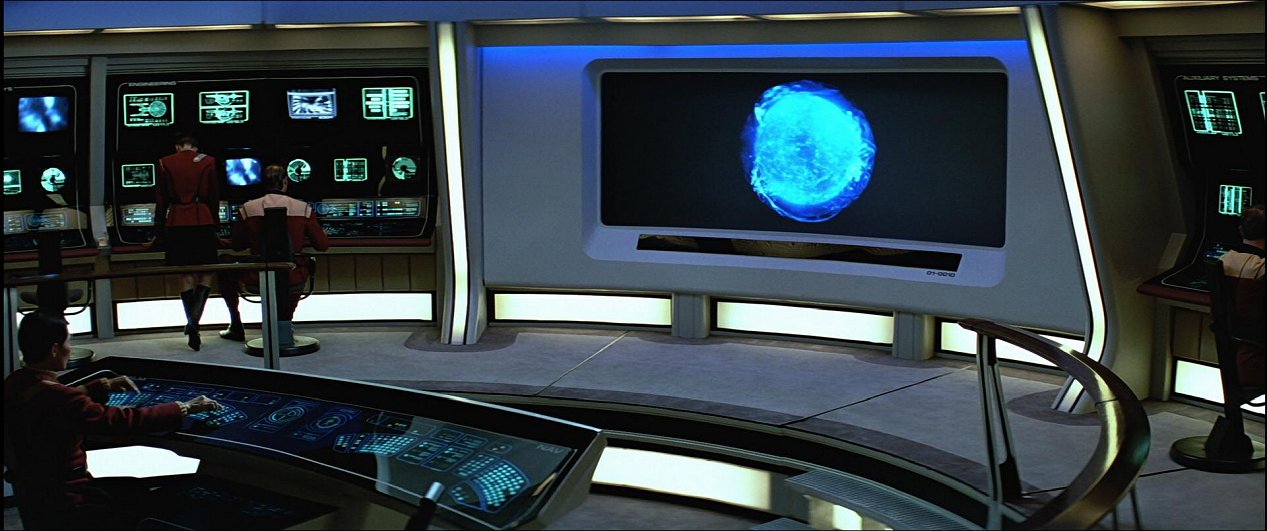
The Bridge module for the U.S.S. Montrose is the original module to be fitted to this starship. During her major refit the module fitted to her originally in 2293 received minor modifications. The module now features all of the improvements made from the mid-2290s, including a specialised Tactical/Engineering station at the rear of the Bridge. Two turbolifts service the Bridge, as well as providing exits for the Ready Room and aft airlock.
The Bridge module has been fully updated and upgraded with the latest technology from 2293 and was upgraded later in the mission. With the new generation Bridge modules showing the advantages of the new tactical/operations station at the rear of the Captains chairs, these older generation of Bridge modules are being refitted.
Author's Notes:
As with the rest of U.S.S. Montrose, this bridge is an upgraded and improved version of the the one seen on the Enterprise-A in Star Trek VI. The main differences are the additional Enterprise-B features of the Tactical/Operations station behind the Captain's chair - an improvement made early in the 2300s - and the large Master Situation Display behind the Tactical station, flanked by two additional Master Situation stations. The digital clocks from Star Trek VI have also been removed.
I chose an Enterprise-A style bridge for the Montrose to give her that 2290s feel, the refit bridge being more in the style of the Sheffield, with the Operations/Tactical station being added and the Master Situation being fit with the large Constellation class display and the original screens moved to the former tactical stations.
Stations (Clockwise from the Main Viewscreen).
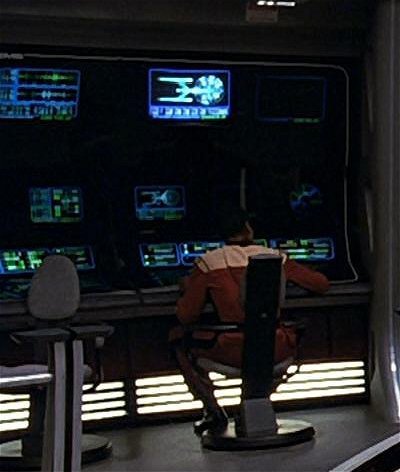
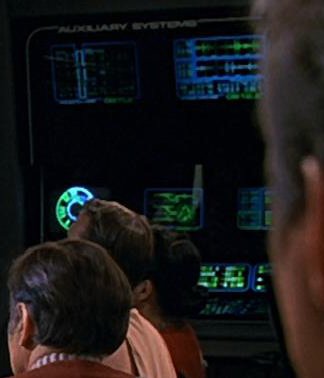 Auxiliary Systems: 2-seat station that provides graphic displays of all command systems, indicating the operational condition of each, schedules of maintainance and/or replacement. It automatically transfers function to auxiliary back-up units in case of general or selective system failure.
Auxiliary Systems: 2-seat station that provides graphic displays of all command systems, indicating the operational condition of each, schedules of maintainance and/or replacement. It automatically transfers function to auxiliary back-up units in case of general or selective system failure.
Many of the ship's systems are automatic [see notes on Ship's Computer] and run independantly of external operation. Montrose's bridge stations usually deal with immediate operations concerning the ship. The remainding, more mundane and repetative functions are controlled by the Main Computer. Should the Bridge crew wish to perform or override any ships function, they may do so with very few vocal or keyboard inputs
The auxiliary systems station is manned by an enlisted engineer, monitoring the many systems on the ship. With the Constellation class starship being designed for prolonged deep-space missions without support for much of the time, the importance of the auxiliary systems and monitoring of the maintainence of the primary systems was more perhaps important than normal.
In Star Trek VI this station is clearly seen manned by an enlisted extra. It is unclear whether they are wearing engineering epaulettes - indeed in the image to the left it is seems to be more a sciences uniform but that could just be a costuming error. With the Constellation class being portrayed by Rick Sternbach as a vessel that could run deep space missions for a decade makes this station vital. With the ability to perform Repenishment At Space (RAS), with starships such as the Mughi class, is reduced as the ship operates far outside the boundaries of the Federation.
As with many stations on the bridge, this clearly shows the role of the enlisted personnel and that not every important role is performed by an officer.
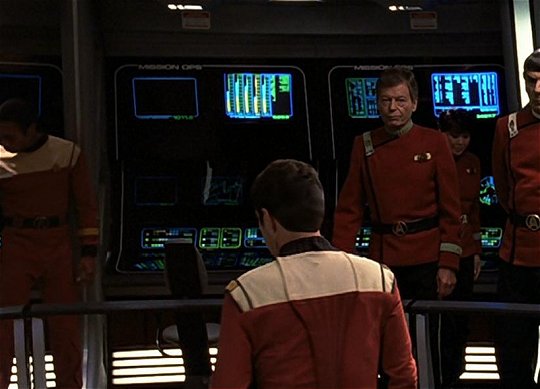
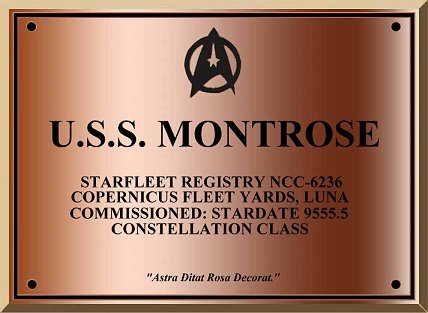 Mission Ops: 2-seat station responsible for the assignment of resources and priorities according to the guidelines specified by the Operations Officer and by operating protocols. Mission Ops ensures computer control does not unduly compromise any mission priorities, especially during unforseen situations. telemetry and tricorder data are monitored from Away Teams and transporter 'windows' are monitored.
Mission Ops: 2-seat station responsible for the assignment of resources and priorities according to the guidelines specified by the Operations Officer and by operating protocols. Mission Ops ensures computer control does not unduly compromise any mission priorities, especially during unforseen situations. telemetry and tricorder data are monitored from Away Teams and transporter 'windows' are monitored.
This is the station for monitoring mission-specific operational requirements, rather than the Operations Manager role of managing the requirements for the starship itself. This station can be manned either by a mission operations officer or by an enlisted member of the crew with a command or engineering specialisation.
Up until the installation of the operations and tactical station in the early 2300s, this was where Operations Officer Lt. Commander Rangi Turoa would be found monitoring the landing parties. Later in his tenure this was manned by an enlisted command division specialist or junior operation officer whilst Turoa and his successor relocated to the aft of the bridge.
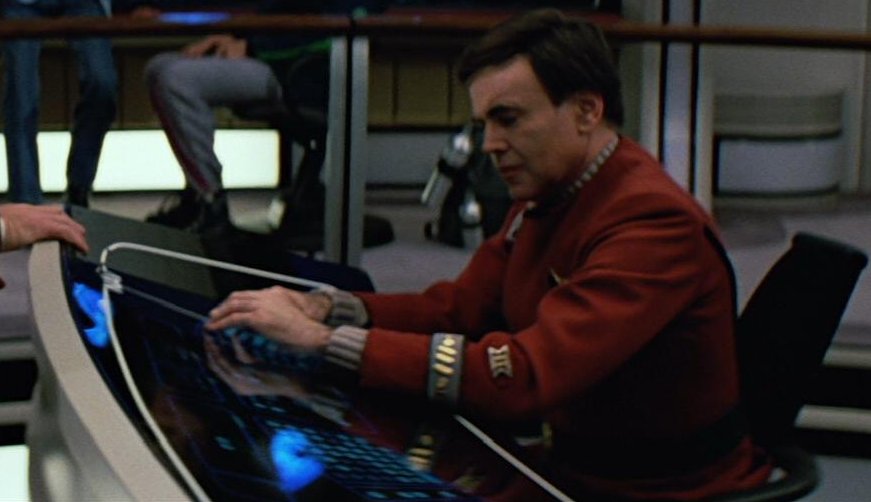 Navigation: This station is responsible for the navigation of Montrose at Impulse and Warp speeds. Navigation displays readings from navigation and tactical sensors, overlaying them on current positional and course projections. Navigation has the option of accessing data feeds from secondary navigation and science sensors, for verification of primary sensor data. Such cross-checks are performed at change-of-shift or activation of Alert status. Flight information input can be done in numerous ways: Destination planet, star system or sector, spacecraft intercept and reletive bearing, Absolute Bearing or Galactic coordinates.
Navigation: This station is responsible for the navigation of Montrose at Impulse and Warp speeds. Navigation displays readings from navigation and tactical sensors, overlaying them on current positional and course projections. Navigation has the option of accessing data feeds from secondary navigation and science sensors, for verification of primary sensor data. Such cross-checks are performed at change-of-shift or activation of Alert status. Flight information input can be done in numerous ways: Destination planet, star system or sector, spacecraft intercept and reletive bearing, Absolute Bearing or Galactic coordinates.
Star Trek VI showed this to be the station of Commander Pavel Chekov. On the Montrose this is the station of a navigation officer Lieutenant. This station is still a combined station with the helm and is still on the right side of the Captain, not yet being reversed. The navigator of the Montrose will be an alien, rather like the days of Lt Arex on the animated Enterprise bridge.
This view shows the hybridisation of the Star Trek V and VI Bridge. I must concede I dislike the Star Trek VI Helm/Navigation station with it's tactile buttons. This was a throwback to the days of the Original Series and Bridge from the first three movies: this had to be shown to have modernised.
The Bridge views for the Starships of the Interim Years are taken from Star Trek IV onwards, with the period Okudagram displays and smooth touchscreen interface systems.
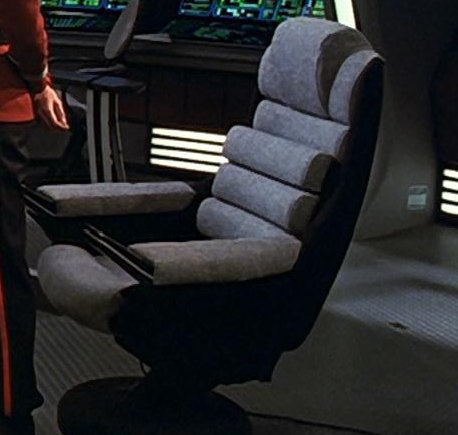 Conn: The captain's chair sits in the centre of the Bridge. From here Captain An'il'taya can see most of the Bridge station displays. The controls on the arms of the chair allow the captain access to communication channels, Ship's Address System and access to the ship's library {LCARS} and main systems computer. The control can also change the ship's status to Yellow or Red Alert. New upgrades in Montrose allow Captain An'il'taya to override the basic operation of the ship, duplicating Helm and Navigation controls and operated by keyboard or vocal command.
Conn: The captain's chair sits in the centre of the Bridge. From here Captain An'il'taya can see most of the Bridge station displays. The controls on the arms of the chair allow the captain access to communication channels, Ship's Address System and access to the ship's library {LCARS} and main systems computer. The control can also change the ship's status to Yellow or Red Alert. New upgrades in Montrose allow Captain An'il'taya to override the basic operation of the ship, duplicating Helm and Navigation controls and operated by keyboard or vocal command.
This is the heart of starship operations. From here, An'il'taya, captain of the Montrose, can quickly gather information from her departments, be advised on the meaning of the findings by her senior staff, and make informed decisions based on the data.
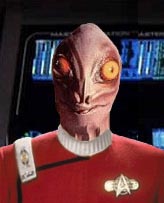 An'il'taya, the Saurian protige of Re'narth Jerbes of the starship Valkyrie, she is the captain that specialised in the mystery-solving aspect of a captain, rather than the tactical and strategic genius of 'Achilles' Stirling and the diplomatic tact of Raekwon Okigbo. Nathaniel Hawkins learned much from her in the ten years he spent aboard, being promoted from Ensign upon his arrival and leaving in 2308 as Operations Officer and Lieutenant Commander.
An'il'taya, the Saurian protige of Re'narth Jerbes of the starship Valkyrie, she is the captain that specialised in the mystery-solving aspect of a captain, rather than the tactical and strategic genius of 'Achilles' Stirling and the diplomatic tact of Raekwon Okigbo. Nathaniel Hawkins learned much from her in the ten years he spent aboard, being promoted from Ensign upon his arrival and leaving in 2308 as Operations Officer and Lieutenant Commander.
An'il'taya graduated from Starfleet Academy in 2279, moving straight into a two year assignment on a Hermes class scout. Having completed that mission as junior science officer she then spent five years onboard a constitution class starship as science officer, followed by a second as operations officer. An'il'taya yearned for the deep-space exploration and learned the importance of having ambitious personnel around her to push the mission forward an achive better results in a quicker manner.
Having excelled in deep space missions her selection for the longer endurance Constellation class starships was inevitable. Captain Re'narth Jerbes was quick to select her for the U.S.S. Valkyrie in 2293 as his Executive Officer. An'il'taya learned quickly from his experience and was soon showing signs she was ready for a command of her own, coming in 2297 as the Montrose was ready for her second mission after a 5 year maiden voyage she was now ready for a decade-long second one.
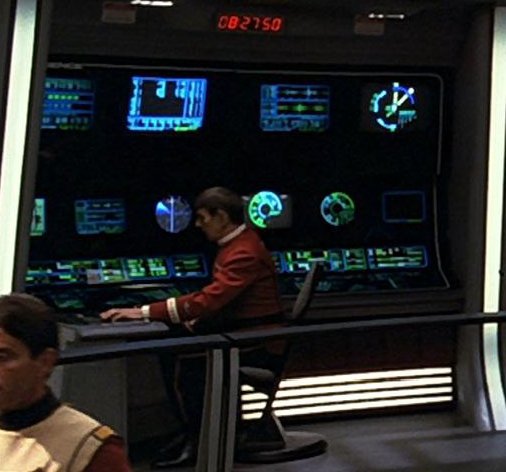 Science: This two-seat high-resolution information processing station is used to provide realtime scientific data in order to supplement Mission Ops in supporting command decision-making. All ship's sensors, both mission-specific and multi-functional, are accessible to the Science Officer. Science can also act as a command post for coordination of activities of various science laboratories and other departments, as well as for monitoring of secondary mission status. Science can reconfigure and recalibrate sensor systems at a moment's notice for specific command intelligence requirements.
Science: This two-seat high-resolution information processing station is used to provide realtime scientific data in order to supplement Mission Ops in supporting command decision-making. All ship's sensors, both mission-specific and multi-functional, are accessible to the Science Officer. Science can also act as a command post for coordination of activities of various science laboratories and other departments, as well as for monitoring of secondary mission status. Science can reconfigure and recalibrate sensor systems at a moment's notice for specific command intelligence requirements.
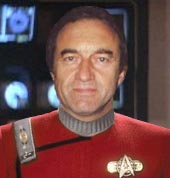 This station was manned by Commander Robert Carter for the first part of the Montrose mission. Carter was the pioneer of idionomothetic technology and this was to be employed upon the Klingons for the post-Khitomer recovery operations dealing with the aftermath of Praxis.
This station was manned by Commander Robert Carter for the first part of the Montrose mission. Carter was the pioneer of idionomothetic technology and this was to be employed upon the Klingons for the post-Khitomer recovery operations dealing with the aftermath of Praxis.
Carter was renowned for his directness and his brutal honesty. Under his wing came Lieutenant (junior grade) Nathaniel Hawkins, learning the ropes of running the social sciences department and deep-space responsibility. Carter evenually took promotion and Hawkins took over at the science station for a time before trainng under Commander Rangi Turoa to be operations officer. Once Hawkins transferred stations to the Operations station, Lieutenant Cassandra Annabell Adams from Manchester, New England, took over as science officer.
With the Constellation class starship being a deep space exploratory star cruiser, the science station is vital both for the stellar phenomena and the encounters with new and unique forms of life. Wth the Montrose this station is very much the launch pad for a career heading towards command via the role of operations officer. In Star Trek VI the blueprint poster states Spock is both Executive Officer and Operations Officer but the two roles must be seperate for one cannot be monitoring the scientific aspects of a mission whilst simultaneously monitoring the material readiness of the starship itself. Spock was undoubtedly awesome, but that would have been something else(!).
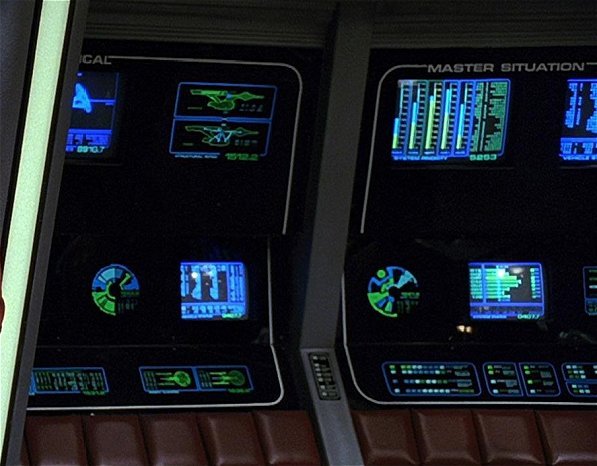 Tactical: Dedicated to starship internal security and defensive systems control. Tactical - this position faced backwards and flanked the Master Situation display until the later addition of the combined Tactical/Operations station. Tactical One was manned by Sitation Control Officer 1 and this was adjacent to the communications station. This monitored and controlled the ship's phaser banks. It monitored low-energy sesor scanning for particulate matter in space. Phaser deflection or destruction of said matter was automatic. Target identification, tracing and selective firing were controlled from this station. An engagement recorder input non-alterable memory of phaser use into the ship's library computer.
Tactical: Dedicated to starship internal security and defensive systems control. Tactical - this position faced backwards and flanked the Master Situation display until the later addition of the combined Tactical/Operations station. Tactical One was manned by Sitation Control Officer 1 and this was adjacent to the communications station. This monitored and controlled the ship's phaser banks. It monitored low-energy sesor scanning for particulate matter in space. Phaser deflection or destruction of said matter was automatic. Target identification, tracing and selective firing were controlled from this station. An engagement recorder input non-alterable memory of phaser use into the ship's library computer.
Tactical Two was adjacent the science station and was manned by Situation Control Officer 2. This controlled the ship's array of warp-capable photon torpedoes, the Constellation class possessing over 100 in the arsenal. With advanced magnetic range-finding and star-nav tracking accuracy is now 98.5%. An engagement recorder records non-alterable memory of moment of detonation, position and strength of impact into the library computer.
Tactical operates in a tier-system: benign, low-level observation of basic crew safety, second tier security during diplomatic and cultural missions and third tier counter-terrorist operations. Security teams can be controlled from Tactical via voice or keyboard input. armoury inventories, security team personnel assignments and detailed directives are all controlled by Tactical.
 The very survival of Montrose may rest in Tactical. In the performance of operations hazardous situations include: celestial bodies, artificial constructs and Threat vessels. A wide variety of defensive options are open to the Tactical Officer including: shields and deflector screens, phasers and photon torpedoes. Tactical coordinates with Helm, Navigation and Science in all situations involving external hazards. Other systems that may be commanded by Tactical include long- and short-range sensor arrays, sensor probes, message buoys and tractor beam devices.
The very survival of Montrose may rest in Tactical. In the performance of operations hazardous situations include: celestial bodies, artificial constructs and Threat vessels. A wide variety of defensive options are open to the Tactical Officer including: shields and deflector screens, phasers and photon torpedoes. Tactical coordinates with Helm, Navigation and Science in all situations involving external hazards. Other systems that may be commanded by Tactical include long- and short-range sensor arrays, sensor probes, message buoys and tractor beam devices.
The tactical/operations station comes into effect later when the bridge is modified. Initially the set-up is just as on the Enterprise-A. Lieutenant Will Kennedy from Leeds in the UK is the tactical officer. Described as taking work hard and play hard to new levels. Kennedy stayed as security chief until promotion to operations officer at the end of the ten year mission.
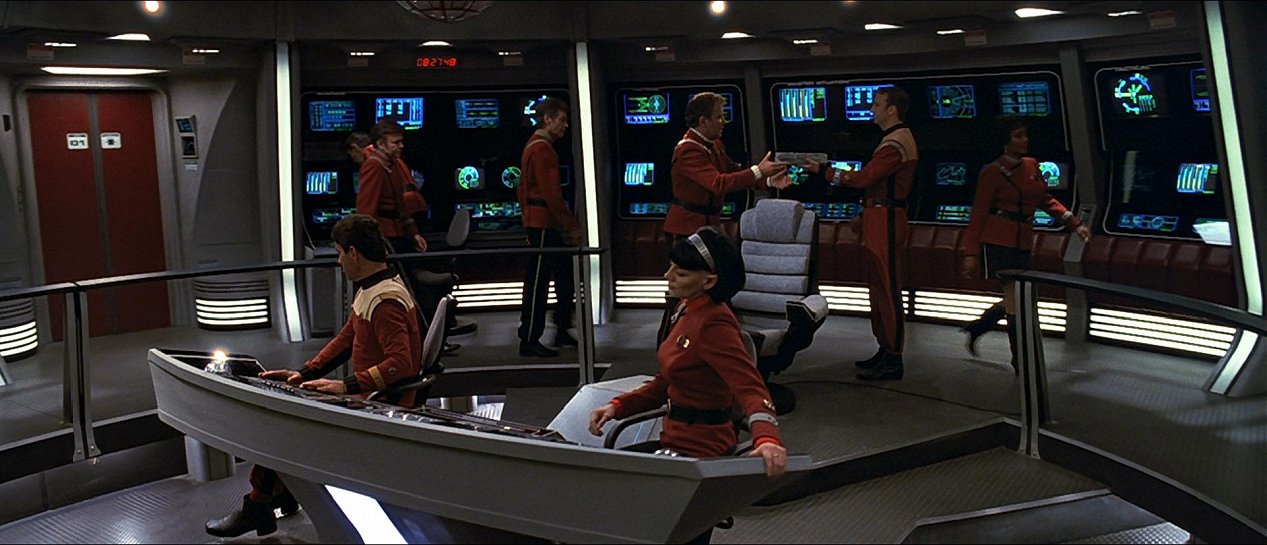
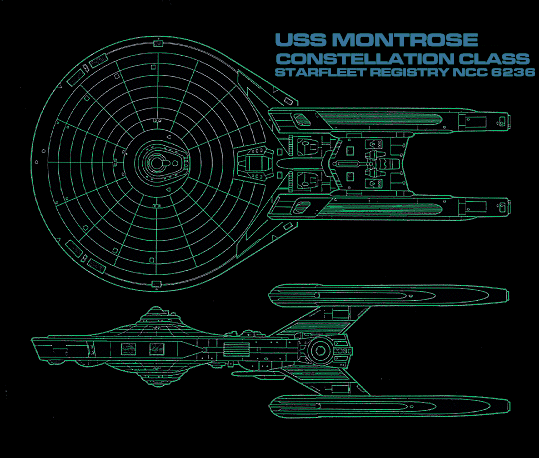
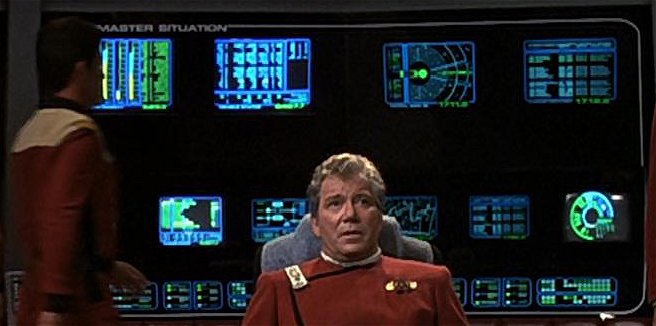
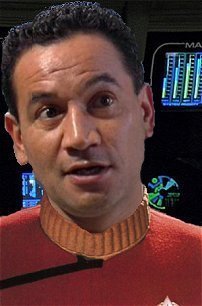 Master Situation: This is a large wall display behind the Tactical and Engineering stations, featuring a cutaway of Montrose. This display shows the location of key systems and hardware, highlighting any elements that are currently experiencing any condition out of nominal. This display also incorporates controls to permit use of this station for troubleshooting.
Master Situation: This is a large wall display behind the Tactical and Engineering stations, featuring a cutaway of Montrose. This display shows the location of key systems and hardware, highlighting any elements that are currently experiencing any condition out of nominal. This display also incorporates controls to permit use of this station for troubleshooting.
This station presents the Operations Officer with a live feed of all activities onboard the ship. This allows the Ops Officer to schedule sensor and resource useage and resolve conflicts. The Operations Officer has the authority to prioritise one request over another in accordance with the standing mission parameters and Captain's orders. This station duplicates, in a simplified form, the Chief Engineer's primary status displays from Main Engineering. These displays include Structural Integrity and Inertial Dampening systems. This station can also operate tractor beam and transporter systems, as well as all the functions of Main Engineering and the Main Computer.
This station is normally manned by the Operations Officer Lieutenant Commander Rangi Turoa. Turoa was a Maori/Polynesian who graduated from the Academy in 2290. He was assigned to the Te Mana as engineer for two years before reassignment to the Valkyrie as engineer. There he met future captain An'il'taya and his position on the Montrose crew was assured. Turoa was promoted to Executive Officer with Nathaniel Hawkins taking his position on Operations. By this point the Enterprise-B style combined forward-facing station is installed and Will Kennedy with Nathaniel Hawkins make an impressive pairing to running the ship. Both soon gained promotion leading Cassandra Adams into the role as Operations Officer.
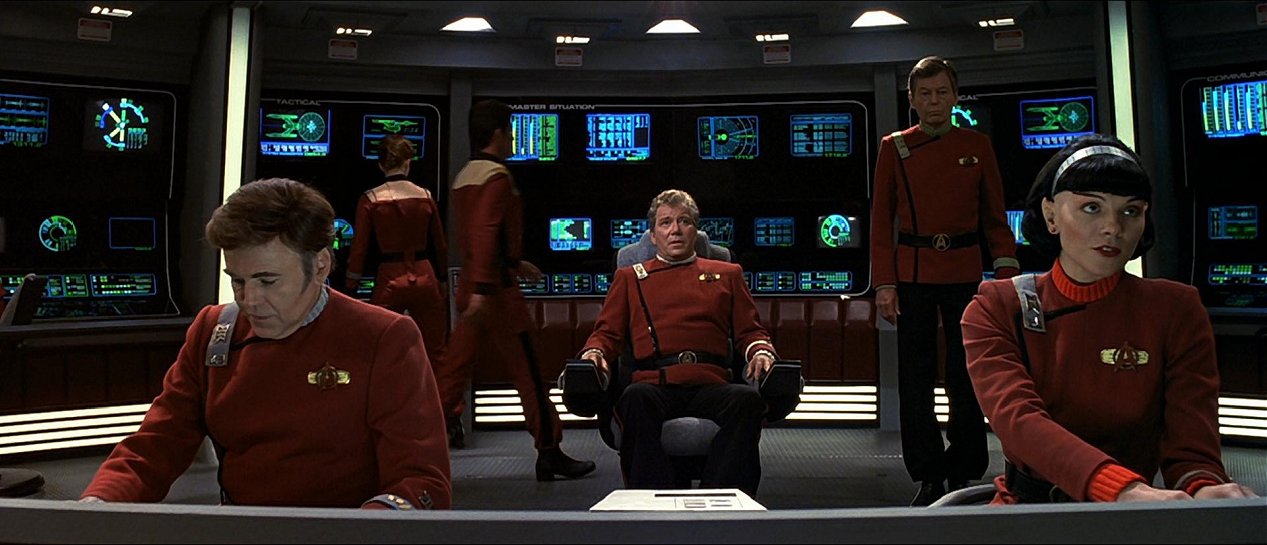
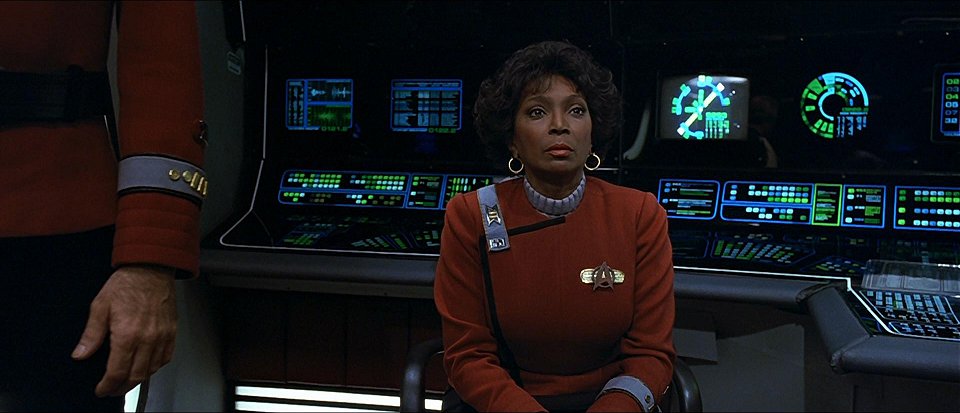 Communications: 2-seat station consisting of a class one capable subspace radio with 74 000 channel capacity receiver and sender of audio/visual transmissions. This system is equipped with a Sternbach/Okuda Language Translator, ultra high-power subspace interference filters, including coding and decoding capabilities. The system also possesses higher encryption levels for secure transmissions and a constant open channel to Starfleet Command. Communications is responsible for intraship communications, ship-to-ship communications and ship-to-ground communications, from messages from one person to another to Main Viewer communication and data transmission transmitting and receiving.
Communications: 2-seat station consisting of a class one capable subspace radio with 74 000 channel capacity receiver and sender of audio/visual transmissions. This system is equipped with a Sternbach/Okuda Language Translator, ultra high-power subspace interference filters, including coding and decoding capabilities. The system also possesses higher encryption levels for secure transmissions and a constant open channel to Starfleet Command. Communications is responsible for intraship communications, ship-to-ship communications and ship-to-ground communications, from messages from one person to another to Main Viewer communication and data transmission transmitting and receiving.
This station is manned by Lieutenant j.g. Lindsey Lloyd, born 2266 in the futuristic metropolis of London, England. Lindsey graduated from Starfleet Academy in the Class of 2287. Lloyd was not a career officer, more concerned with enjoying seeing and experiencing the sights and delights of unexplored deep space. It was always said that Lindsey was always planning her next shoreleave. Lindsey was both intelligent mixed with playful and bubbly personality, often with gentle teasing thrown in. There were rumours during the Montrose mission that Lloyd liked to sample all aspects of alien and new cultures - including the recreational and sexual aspects. How much of this was sheer scuttlebutt and how much was based in fact was never made clear.
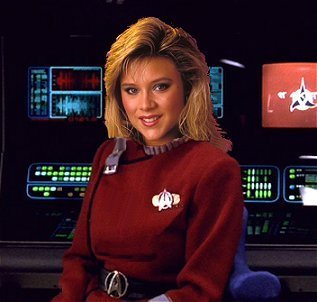
 Lindsey Lloyd joined the Montrose in 2298 for the exploration into the Beta Quadrant. She had proved herself apt with the classified communications sensors onboard the Montrose. She had passed Klingon, Romulan and Vulcan languages with top marks and her Gorn, Ferasan and Tholian knowledge was equally impressive. For Nathaniel Hawkins, Lindsey presented both an attractive distraction from his work on the Bridge, as well as the knowledge that she was 'out of his league'. He contented himself with her being a friend and colleague, although the rumoured encounters she had didn't sit comfortably with him.
Lindsey Lloyd joined the Montrose in 2298 for the exploration into the Beta Quadrant. She had proved herself apt with the classified communications sensors onboard the Montrose. She had passed Klingon, Romulan and Vulcan languages with top marks and her Gorn, Ferasan and Tholian knowledge was equally impressive. For Nathaniel Hawkins, Lindsey presented both an attractive distraction from his work on the Bridge, as well as the knowledge that she was 'out of his league'. He contented himself with her being a friend and colleague, although the rumoured encounters she had didn't sit comfortably with him.
Much of Lloyd's past remains a mystery. Whilst there is no doubting her communications and linguistic skills, she also does boxing and martial arts, suggesting either the special services or security departments may have featured in her earlier career. Lloyd was unashamed of her looks and would use them to get what she wanted, yet her mind was equally bright- allowing her to let opponents be overawed by her looks, underestimate her and then fall foul of her plans. Hawkins had coaching from Lloyd about unarmed combat following his incident with Klingon L'mak and a brawl. Many joked Hawkins should have had the training beforehand...
Who else but eighties legend Samantha Fox could be cast as the bubbly Cockney communications officer of the Montrose? This character is designed to provide a bit of mystery, a love interest and a character with many facets. More on Lloyd as her character and backhistory develops.
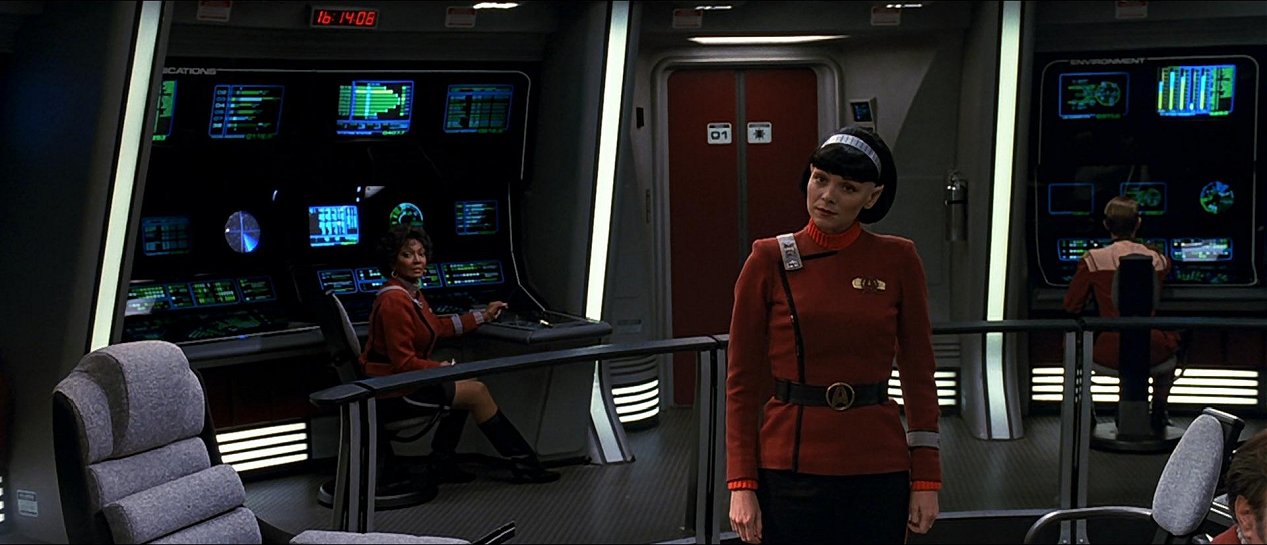

Helm: Manned by the Helm Control Officer. Responsibilities include: status of shipboard activities, supervision of power allocations, continuous revised Action Status Menus for command review, designated weapon control and shield activation (if no Tactical Officer present). Helm is also responsible for manual flight operations including: monitoring relativistic effects at impulse speeds as well as inertial dampening status. During Alert status, flight rules permit Helm to specify manoevres that are potentially dangerous to the ship or crew.
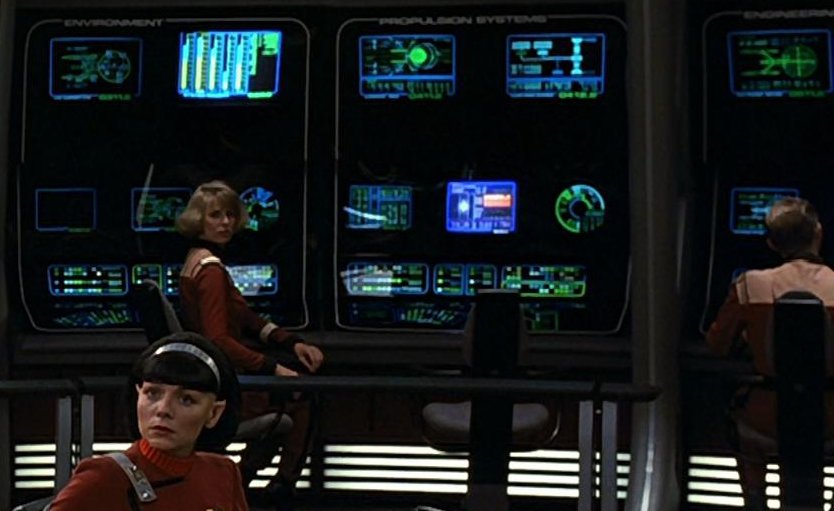 Environment: The single-seat Environment station monitors and controls life support systems including: artificial gravity, heat exchange, food synthesis and service, water, waste management and hazardous waste management. During Alert and crisis situations, Environment monitors and allocates life support resources to maximise crew survivability. The Environmental System Officer is authorized to initiate Yellow and Red Alert conditions and is responsible for the execution of survival scenarios such as evacuation to environmental shelter areas.
Environment: The single-seat Environment station monitors and controls life support systems including: artificial gravity, heat exchange, food synthesis and service, water, waste management and hazardous waste management. During Alert and crisis situations, Environment monitors and allocates life support resources to maximise crew survivability. The Environmental System Officer is authorized to initiate Yellow and Red Alert conditions and is responsible for the execution of survival scenarios such as evacuation to environmental shelter areas.
One of the most vital stations on the bridge. This was the station Hawkins first manned on the old Constitution class U.S.S Potemkin. This station is usually manned by an engineering division enlisted crewperson. The system - like most on the Montrose - usually operates on a fairly automated basis, reflecting the lean-manning approach to starship operation.
Although this should be an engineering division enlisted crewmember in Star Trek VI it was clearly manned by a command division enlisted person of rank petty officer or above. Perhaps the shortage of crew for such a rushed mission caused the problem or maybe just one of those costuming errors/ quick decisions for background extras.
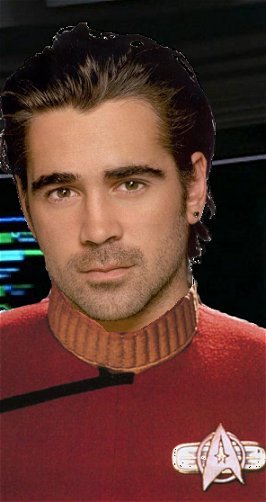 Propulsion Systems: single-seat station that monitors the Reaction Control Thrusters, Impulse and Warp Drive systems, deuterium and antimatter fuel usage and reserves involved in making Montrose move. In full enable mode this console can actively override and control all propulsion systems. Deuterium fuel levels and anti-matter are all monitored from here, allowing the cptan to know when the ship needs to rendezvous with a tanker to refuel. Not so essential for the antimatter as it lasts a while but vital for the hydrogen for the impulse engines.
Propulsion Systems: single-seat station that monitors the Reaction Control Thrusters, Impulse and Warp Drive systems, deuterium and antimatter fuel usage and reserves involved in making Montrose move. In full enable mode this console can actively override and control all propulsion systems. Deuterium fuel levels and anti-matter are all monitored from here, allowing the cptan to know when the ship needs to rendezvous with a tanker to refuel. Not so essential for the antimatter as it lasts a while but vital for the hydrogen for the impulse engines.
Engineering: This single-seat station duplicates the function of the Chief Engineer station in Main Engineering. This station deliberately is out of line-of-sight for ship-to-ship communications. This station monitors the Matter/Anti-Matter reactor and power systems of the Montrose, EPS conduit performance as well as on-demand engineering analysis of the performance of any of the systems of the ship, their maintainance schedules and records.
This is another station normally manned by an engineering enlisted person. Normally this post requires only monitoring but can be used for overriding in an emergency. The Chief Engineering Officer may use this station to duplicate functions from Main Engineering should he wish. In Star Trek VI this station was unmanned except during red alert situations, reflecting the wisdom of the decription of the station.
Lieutenant jg Sean O'Reilly could occasionally be seen at this station, sent up from Engineering to monitor the warp and impulse systems of the Montrose. O'Reilly has had a long history with Nathaniel Hawkins, staying with him through Starfleet Academy and onto this first assignment. O'Reilly was renowned as a ladies man, with his Irish charm winning hearts for him. His engineering skills matched that charm and O'Reilly always raced Hawkins for promotions.
O'Reilly would later be selected by Hawkins to transfer to the U.S.S. Sheffield as Chief Engineering Officer. O'Reilly would later date Hawkins' ex, Judith Peers, causing some strain in their relationship. During his time on the Montrose, O'Reilly was a party hard person, moving on from his own demons at the Academy.
Colin Farrell was the obvious choice for O'Reilly's visage. Farrell is actually some 4 years younger than this character- he obviously aged well. My thanks to Sean Teeling of the Star Trek: Grissom team for the details on O'Reilly. More to follow...
.
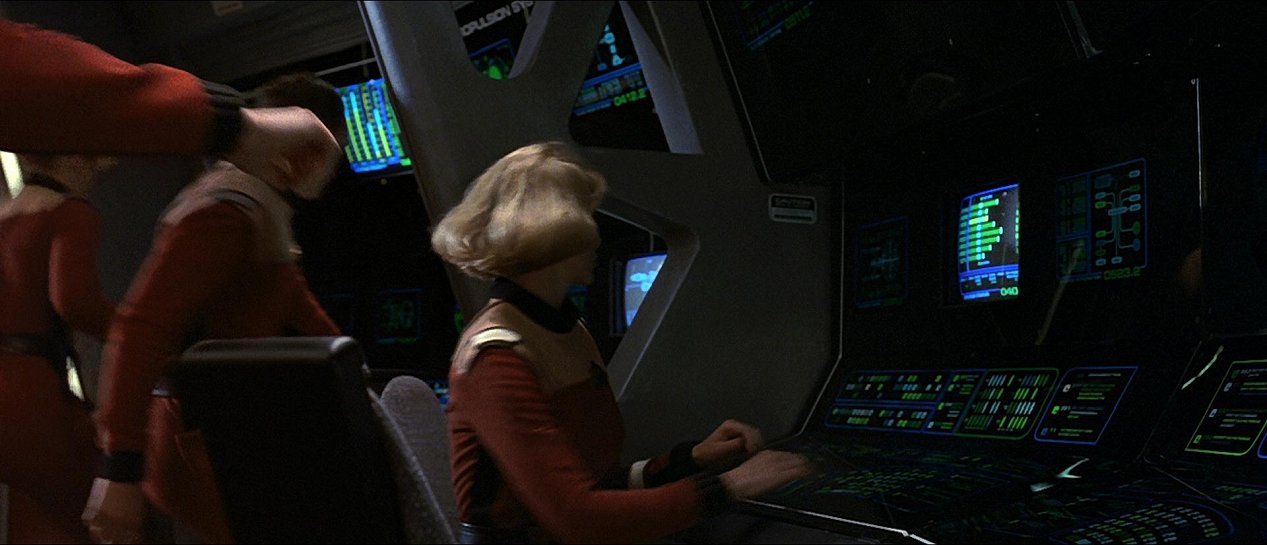
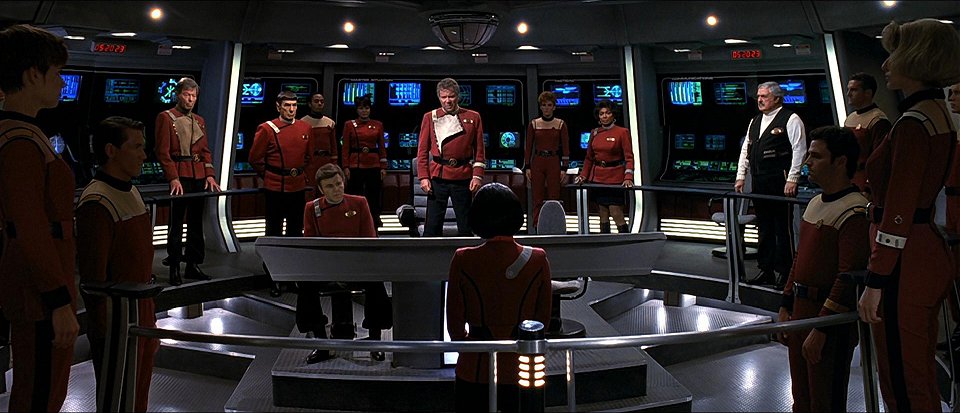
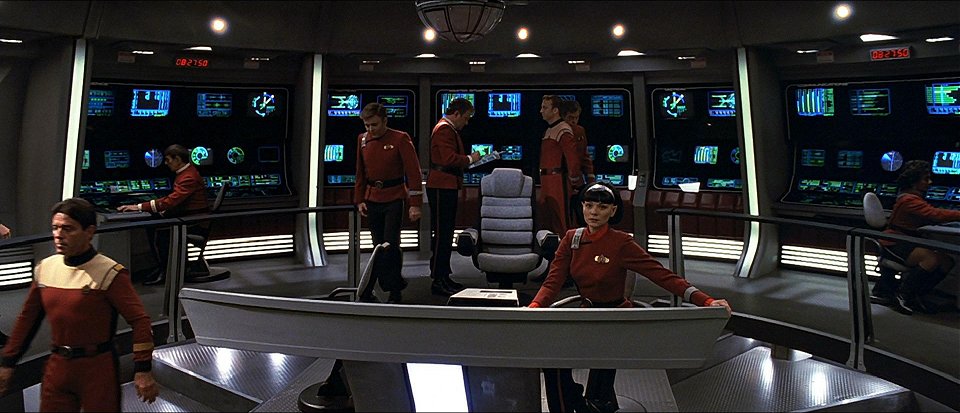
Diagram of the Main Bridge:
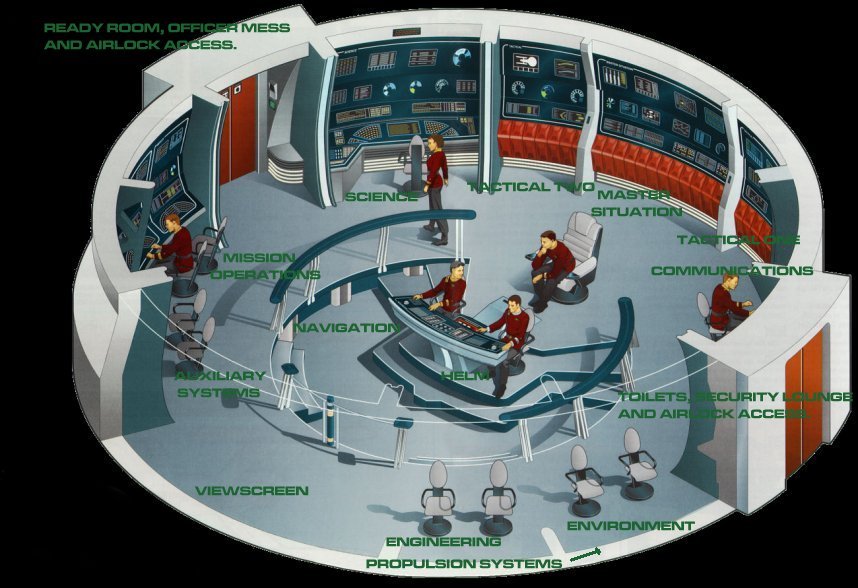
"The above artwork is © Star Trek Fact Files. All rights reserved"








 Auxiliary Systems: 2-seat station that provides graphic displays of all command systems, indicating the operational condition of each, schedules of maintainance and/or replacement. It automatically transfers function to auxiliary back-up units in case of general or selective system failure.
Auxiliary Systems: 2-seat station that provides graphic displays of all command systems, indicating the operational condition of each, schedules of maintainance and/or replacement. It automatically transfers function to auxiliary back-up units in case of general or selective system failure.
 Mission Ops: 2-seat station responsible for the assignment of resources and priorities according to the guidelines specified by the Operations Officer and by operating protocols. Mission Ops ensures computer control does not unduly compromise any mission priorities, especially during unforseen situations. telemetry and tricorder data are monitored from Away Teams and transporter 'windows' are monitored.
Mission Ops: 2-seat station responsible for the assignment of resources and priorities according to the guidelines specified by the Operations Officer and by operating protocols. Mission Ops ensures computer control does not unduly compromise any mission priorities, especially during unforseen situations. telemetry and tricorder data are monitored from Away Teams and transporter 'windows' are monitored. Navigation: This station is responsible for the navigation of Montrose at Impulse and Warp speeds. Navigation displays readings from navigation and tactical sensors, overlaying them on current positional and course projections. Navigation has the option of accessing data feeds from secondary navigation and science sensors, for verification of primary sensor data. Such cross-checks are performed at change-of-shift or activation of Alert status. Flight information input can be done in numerous ways: Destination planet, star system or sector, spacecraft intercept and reletive bearing, Absolute Bearing or Galactic coordinates.
Navigation: This station is responsible for the navigation of Montrose at Impulse and Warp speeds. Navigation displays readings from navigation and tactical sensors, overlaying them on current positional and course projections. Navigation has the option of accessing data feeds from secondary navigation and science sensors, for verification of primary sensor data. Such cross-checks are performed at change-of-shift or activation of Alert status. Flight information input can be done in numerous ways: Destination planet, star system or sector, spacecraft intercept and reletive bearing, Absolute Bearing or Galactic coordinates. Conn: The captain's chair sits in the centre of the Bridge. From here Captain An'il'taya can see most of the Bridge station displays. The controls on the arms of the chair allow the captain access to communication channels, Ship's Address System and access to the ship's library {LCARS} and main systems computer. The control can also change the ship's status to Yellow or Red Alert. New upgrades in Montrose allow Captain An'il'taya to override the basic operation of the ship, duplicating Helm and Navigation controls and operated by keyboard or vocal command.
Conn: The captain's chair sits in the centre of the Bridge. From here Captain An'il'taya can see most of the Bridge station displays. The controls on the arms of the chair allow the captain access to communication channels, Ship's Address System and access to the ship's library {LCARS} and main systems computer. The control can also change the ship's status to Yellow or Red Alert. New upgrades in Montrose allow Captain An'il'taya to override the basic operation of the ship, duplicating Helm and Navigation controls and operated by keyboard or vocal command. An'il'taya, the Saurian protige of Re'narth Jerbes of the starship Valkyrie, she is the captain that specialised in the mystery-solving aspect of a captain, rather than the tactical and strategic genius of 'Achilles' Stirling and the diplomatic tact of Raekwon Okigbo. Nathaniel Hawkins learned much from her in the ten years he spent aboard, being promoted from Ensign upon his arrival and leaving in 2308 as Operations Officer and Lieutenant Commander.
An'il'taya, the Saurian protige of Re'narth Jerbes of the starship Valkyrie, she is the captain that specialised in the mystery-solving aspect of a captain, rather than the tactical and strategic genius of 'Achilles' Stirling and the diplomatic tact of Raekwon Okigbo. Nathaniel Hawkins learned much from her in the ten years he spent aboard, being promoted from Ensign upon his arrival and leaving in 2308 as Operations Officer and Lieutenant Commander. Science: This two-seat high-resolution information processing station is used to provide realtime scientific data in order to supplement Mission Ops in supporting command decision-making. All ship's sensors, both mission-specific and multi-functional, are accessible to the Science Officer. Science can also act as a command post for coordination of activities of various science laboratories and other departments, as well as for monitoring of secondary mission status. Science can reconfigure and recalibrate sensor systems at a moment's notice for specific command intelligence requirements.
Science: This two-seat high-resolution information processing station is used to provide realtime scientific data in order to supplement Mission Ops in supporting command decision-making. All ship's sensors, both mission-specific and multi-functional, are accessible to the Science Officer. Science can also act as a command post for coordination of activities of various science laboratories and other departments, as well as for monitoring of secondary mission status. Science can reconfigure and recalibrate sensor systems at a moment's notice for specific command intelligence requirements. This station was manned by Commander Robert Carter for the first part of the Montrose mission. Carter was the pioneer of idionomothetic technology and this was to be employed upon the Klingons for the post-Khitomer recovery operations dealing with the aftermath of Praxis.
This station was manned by Commander Robert Carter for the first part of the Montrose mission. Carter was the pioneer of idionomothetic technology and this was to be employed upon the Klingons for the post-Khitomer recovery operations dealing with the aftermath of Praxis. Tactical: Dedicated to starship internal security and defensive systems control. Tactical - this position faced backwards and flanked the Master Situation display until the later addition of the combined Tactical/Operations station. Tactical One was manned by Sitation Control Officer 1 and this was adjacent to the communications station. This monitored and controlled the ship's phaser banks. It monitored low-energy sesor scanning for particulate matter in space. Phaser deflection or destruction of said matter was automatic. Target identification, tracing and selective firing were controlled from this station. An engagement recorder input non-alterable memory of phaser use into the ship's library computer.
Tactical: Dedicated to starship internal security and defensive systems control. Tactical - this position faced backwards and flanked the Master Situation display until the later addition of the combined Tactical/Operations station. Tactical One was manned by Sitation Control Officer 1 and this was adjacent to the communications station. This monitored and controlled the ship's phaser banks. It monitored low-energy sesor scanning for particulate matter in space. Phaser deflection or destruction of said matter was automatic. Target identification, tracing and selective firing were controlled from this station. An engagement recorder input non-alterable memory of phaser use into the ship's library computer. The very survival of Montrose may rest in Tactical. In the performance of operations hazardous situations include: celestial bodies, artificial constructs and Threat vessels. A wide variety of defensive options are open to the Tactical Officer including: shields and deflector screens, phasers and photon torpedoes. Tactical coordinates with Helm, Navigation and Science in all situations involving external hazards. Other systems that may be commanded by Tactical include long- and short-range sensor arrays, sensor probes, message buoys and tractor beam devices.
The very survival of Montrose may rest in Tactical. In the performance of operations hazardous situations include: celestial bodies, artificial constructs and Threat vessels. A wide variety of defensive options are open to the Tactical Officer including: shields and deflector screens, phasers and photon torpedoes. Tactical coordinates with Helm, Navigation and Science in all situations involving external hazards. Other systems that may be commanded by Tactical include long- and short-range sensor arrays, sensor probes, message buoys and tractor beam devices.


 Master Situation: This is a large wall display behind the Tactical and Engineering stations, featuring a cutaway of Montrose. This display shows the location of key systems and hardware, highlighting any elements that are currently experiencing any condition out of nominal. This display also incorporates controls to permit use of this station for troubleshooting.
Master Situation: This is a large wall display behind the Tactical and Engineering stations, featuring a cutaway of Montrose. This display shows the location of key systems and hardware, highlighting any elements that are currently experiencing any condition out of nominal. This display also incorporates controls to permit use of this station for troubleshooting.
 Communications: 2-seat station consisting of a class one capable subspace radio with 74 000 channel capacity receiver and sender of audio/visual transmissions. This system is equipped with a Sternbach/Okuda Language Translator, ultra high-power subspace interference filters, including coding and decoding capabilities. The system also possesses higher encryption levels for secure transmissions and a constant open channel to Starfleet Command. Communications is responsible for intraship communications, ship-to-ship communications and ship-to-ground communications, from messages from one person to another to Main Viewer communication and data transmission transmitting and receiving.
Communications: 2-seat station consisting of a class one capable subspace radio with 74 000 channel capacity receiver and sender of audio/visual transmissions. This system is equipped with a Sternbach/Okuda Language Translator, ultra high-power subspace interference filters, including coding and decoding capabilities. The system also possesses higher encryption levels for secure transmissions and a constant open channel to Starfleet Command. Communications is responsible for intraship communications, ship-to-ship communications and ship-to-ground communications, from messages from one person to another to Main Viewer communication and data transmission transmitting and receiving.
 Lindsey Lloyd joined the Montrose in 2298 for the exploration into the Beta Quadrant. She had proved herself apt with the classified communications sensors onboard the Montrose. She had passed Klingon, Romulan and Vulcan languages with top marks and her Gorn, Ferasan and Tholian knowledge was equally impressive. For Nathaniel Hawkins, Lindsey presented both an attractive distraction from his work on the Bridge, as well as the knowledge that she was 'out of his league'. He contented himself with her being a friend and colleague, although the rumoured encounters she had didn't sit comfortably with him.
Lindsey Lloyd joined the Montrose in 2298 for the exploration into the Beta Quadrant. She had proved herself apt with the classified communications sensors onboard the Montrose. She had passed Klingon, Romulan and Vulcan languages with top marks and her Gorn, Ferasan and Tholian knowledge was equally impressive. For Nathaniel Hawkins, Lindsey presented both an attractive distraction from his work on the Bridge, as well as the knowledge that she was 'out of his league'. He contented himself with her being a friend and colleague, although the rumoured encounters she had didn't sit comfortably with him.


 Environment: The single-seat Environment station monitors and controls life support systems including: artificial gravity, heat exchange, food synthesis and service, water, waste management and hazardous waste management. During Alert and crisis situations, Environment monitors and allocates life support resources to maximise crew survivability. The Environmental System Officer is authorized to initiate Yellow and Red Alert conditions and is responsible for the execution of survival scenarios such as evacuation to environmental shelter areas.
Environment: The single-seat Environment station monitors and controls life support systems including: artificial gravity, heat exchange, food synthesis and service, water, waste management and hazardous waste management. During Alert and crisis situations, Environment monitors and allocates life support resources to maximise crew survivability. The Environmental System Officer is authorized to initiate Yellow and Red Alert conditions and is responsible for the execution of survival scenarios such as evacuation to environmental shelter areas. Propulsion Systems: single-seat station that monitors the Reaction Control Thrusters, Impulse and Warp Drive systems, deuterium and antimatter fuel usage and reserves involved in making Montrose move. In full enable mode this console can actively override and control all propulsion systems. Deuterium fuel levels and anti-matter are all monitored from here, allowing the cptan to know when the ship needs to rendezvous with a tanker to refuel. Not so essential for the antimatter as it lasts a while but vital for the hydrogen for the impulse engines.
Propulsion Systems: single-seat station that monitors the Reaction Control Thrusters, Impulse and Warp Drive systems, deuterium and antimatter fuel usage and reserves involved in making Montrose move. In full enable mode this console can actively override and control all propulsion systems. Deuterium fuel levels and anti-matter are all monitored from here, allowing the cptan to know when the ship needs to rendezvous with a tanker to refuel. Not so essential for the antimatter as it lasts a while but vital for the hydrogen for the impulse engines.






